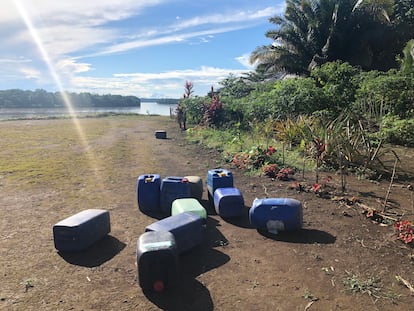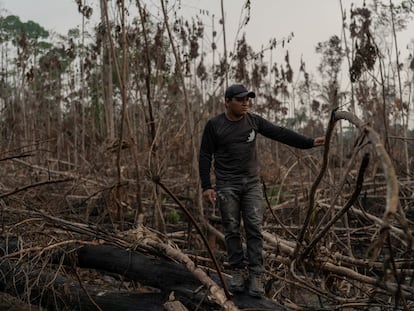How the wind power boom is driving deforestation in the Amazon
Demand for balsa wood, which is used to make turbine blades, has spiked to the point that it is causing significant damage to indigenous communities in Ecuador
What does the deforestation of balsa wood in Ecuador’s Amazon region have to do with wind power generation in Europe? There is a perverse link between the two: a drive for renewable energy has boosted global demand for a prized species of wood that grows in the world’s largest rainforest. As Europe and China increase the construction of blades for wind turbines, balsa trees are being felled to accelerate an energy transition driven by the need to decarbonize the global economy.
In the indigenous territories of the Ecuadorian Amazon, people began to notice an uptick in international demand for balsa wood from 2018 onwards. Balsa is very flexible but tough at the same time, and offers a light yet durable option for long-term wind power production. The typical blades of a wind turbine are currently around 80 meters long, and the new generation of blades can extend up to 100 meters. That means about 150 cubic meters of wood are required to build a single unit, according to calculations by the United States National Renewable Energy Laboratory.
Ecuador is the world’s main exporter of balsa wood, holding 75% of the global market. Major players include Plantabal S.A. in Guayaquil, which has around 10,000 hectares dedicated to the cultivation of balsa wood destined for export. With the boom in demand starting in 2018, this company and many others struggled to cope with the quantity of international orders.
This increase has led directly to the deforestation of the Amazon. Irregular and illegal logging has proliferated by those who have reacted to the scarcity of wood grown for timber by chopping down the virgin balsa that grows on the islands and riverbanks of the Amazon. The impact on the indigenous people who live in the area has been as devastating as mining, oil and rubber were in their day.
In the province of Pastaza on the border with Peru, the accelerated construction of a highway through Shuar people’s territory to link the western city of Puyo with a pier on the Pastaza River generated controversy in 2019. At the gateway to the Amazon, the Shuar and Achuar peoples perceived the road as infrastructure for extraction and deforestation, not as a contribution to the development of their communities. But the project went ahead regardless without their consent, and the road was completed in November 2019.
Thousands of kilometers away, the president of the European Commission, Ursula von der Leyen, was telling an audience in Brussels about the European Union’s ambitious European Green Deal, which aims to foster a transition to a carbon neutral economy to tackle climate change. Von der Leyen presented the plan with these words: “The European Green Deal is Europe’s new growth strategy. It will cut emissions while also creating jobs and improving our quality of life. For that we need investment. Investment in research, innovation, green technologies. To pull this off, we will deliver a Sustainable Europe Investment Plan which will support one trillion euros of investment over the next decade.”

Renewable energy is increasingly cheap to produce, and the backing of governments in the West has boosted the installation of wind turbines in Europe. The same has happened in China, which is also trying to increase the share of renewables in its energy mix. In December 2020, President Xi Jinping declared that China’s 243 gigawatts of wind and solar energy capacity would rise to more than 1,200 by 2030.
Wind power fever has driven a fever for balsa wood, with devastating consequences for Ecuador’s indigenous communities. In September of this year in Achuar territory, the total deforestation of balsa trees was clearly visible on the Pastaza River, and the loggers had moved on to neighboring Peru. Although prices were already beginning to drop, the loggers continued to travel up the Pastaza with large canoes to unload the logs in Copataza, where they were put onto trucks and driven away along the new highway.
In June, Achuar indigenous leaders began to speak out. “Don’t make any investment, even if you cut down balsa you will not be able to remove it, and it will not be sold,” they posted on Facebook, adding that they would not allow the balsa wood to leave their territory for the city. “This is an urgent call for us to understand the serious problems this brings to neighboring countries such as Peru. The loggers are causing division between brothers.” By then, it was already too late.
Sharamentsa is a community that has bet on energy innovation itself, with a solar-powered canoe project. It had resisted opening its islands to loggers, but a local leader bowed to pressure and sold off the community’s balsa trees, causing an uproar and a clear division among families.
The felling of balsa trees also has consequences for the islands’ ecosystem and for the river. The loggers trail alcohol, drugs and prostitution in their wake, and contaminate extraction sites with plastic, cans, machinery, gasoline and oil. They abandon used chainsaw chains, eat the turtles and chase away parrots, toucans and other birds that feed on the flowers of the balsa trees. Illegal deforestation has profound impacts on the balance of flora and fauna, pushing the ecosystem to the breaking point.

The Amazon’s defenders are calling for the wind turbine industry to implement strict measures to determine the origin of the wood used in turbine blades, and to prevent market pressure leading to deforestation. Ultimately, they say, balsa wood should be replaced by other materials.
The price increase due to high demand and insufficient supply is already encouraging the industry to look for alternative materials. The cost of balsa wood doubled from mid-2019 to mid-2020, according to The Economist. In 2019, Ecuador’s balsa exports were worth almost €195 million, 30% more than the previous record from 2015. In the first 11 months of 2020, this jumped to €696 million.
Wind turbine blades are mainly made from polymethacrylamide (PMI) foam, balsa wood and polyethylene terephthalate (PET) foam. A typical design will use balsa for the load-bearing part near the center of the blade, and PVC foam as it approaches the tip of the blades. However, there is increasingly a need to build longer and lighter blades, as well as to ensure a reliable supply chain. PET, a low-density foam generated from plastic bottles, is a substitute. Danish company LM WindPower has used PET since 2017. “Today we use PET foam in blades of more than 80 meters,” said Paul Dansereau, a materials engineer at the company, adding that 60% of this material is recycled.
The Spanish-German company Siemens-Gamesa is among the world’s largest manufacturers of wind turbines. They manufacture blades at the Ria Blades de Vago factory in Portugal with balsa wood that is cut down more than 10,000 kilometers away in Ecuador. When large companies like this one first introduced blade designs using PET only, other competitors soon followed. Wood Mackenzie, a consultancy firm, forecasts that this “will increase from 20% in 2018 to more than 55% in 2023, while demand for balsa will remain stable.”
Impact on recycling and territory

The blades also present a problem for recycling. The first generation of wind turbines are reaching the end of their lives, and thousands will need to be dismantled. “Currently, 85 to 90% of the total mass of wind generators can be recycled,” said Ramón González-Drigo, a professor of structural engineering at the Polytechnic University of Catalonia. “But the blades represent a challenge due to their composite materials, as their recycling requires very specific processes. The manufacture of wind turbine blades requires technical solutions that are both sustainable, economically viable, and responsible, and that fit into a circular economy model,” he added.
The social and environmental impact of wind farms does not end with the deforestation of the Amazon basin, but extends to the territories in countries like Spain where they eventually operate. These are sparsely populated communities with constant winds, and where local opposition is scattered by low population density and isolation.
Matarraña, an area in the Spanish province of Teruel, is home to several wind farm projects that are slated for construction in the short term. Spain has pledged to increase wind energy production, which currently accounts for 21.9% of the electricity consumed in the country. The local population feels powerless in the face of the arrival of million-euro projects that affect plants, wildlife, the landscape and even social harmony. “We have a debate between the need for renewable energies, where wind farms have a very clear role, and the need to preserve the territory, the landscape. This does not fit together very well,” said Eduard Susanna, an olive oil producer.

Esperanza Miravete, a geography and history teacher in Valjunquera, a town of 338 inhabitants in Matarraña, criticizes the “very strong aggression” of wind power companies on the territory. “There is no one protecting the landscape, and there is no natural park or anything that could stop an industrial project here,” she said.
Wind turbines are a key component of the energy transition within the framework of the European Green Deal, but the production of balsa wood for blades and the rise of large wind farms in rural areas present problems for diverse ecosystems and host communities.
The energy transition poses a green paradox, and wind power companies must be able to provide a clear answer to this question. When Europeans turn on the heating this winter, they have a right to know just how clean their energy really is.
More information


